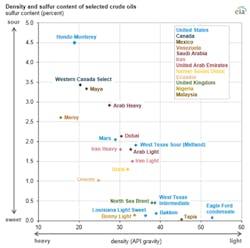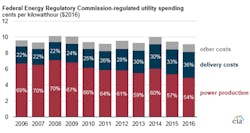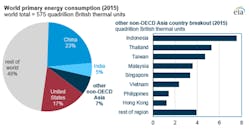China’s LNG imports set new record in 2017
Over the first seven months of 2017, China’s imports of liquefied natural gas (LNG) averaged 4.3 billion cubic feet per day (Bcf/d), or 45 percent higher than during the same period in 2016. Except for a slight decline in 2015, LNG import into China have grown steadily over the last decade, increasing by 33 percent between 2015 and 2016. LNG imports growth has been supported by both government policies to replace some coal and oil use with natural gas as well as lower natural gas import prices. Next year, EIA projects that China will overtake South Korea as the world’s second largest LNG importer, as additional re-gasification terminals come online and LNG supply contracts ramp up.
Study suggests UK oil and gas reserves may last only a decade
Research into the Scottish and U.K. oil industries suggests almost 10 percent of their recoverable oil and gas remains and fracking will hardly be economically feasible in the because of a lack of sites with suitable geology. The study predicts the U.K. may soon have to import all the oil and gas it needs. A move towards greater use of renewable energy sources, particularly offshore wind and advanced solar energy technologies is recommended. Scientists from the University of Edinburgh examined and found that the UK has only minimal potential for fracking. Analysis of hydrocarbon reserves shows that discoveries have consistently lagged output since the point of peak oil recovery in the late 1990s. The research predicts that both oil and gas reserves will run out within a decade. The study, in The Edinburgh Geologist, is published by the Edinburgh Geological Society.
US oil companies increased liquids production and cash flow in the second quarter of 2017
Cash from operations for 55 companies totaled $11.9 billion in the second quarter of 2017, which was $3.8 billion higher than the same period in 2016 and the highest level for any quarter since the third quarter of 2015. Higher crude oil prices and production contributed to the increase in cash from operations. Second-quarter 2017 financial statements for 55 U.S. oil companies indicate that aggregate liquids production grew year over year for the first time since the fourth quarter of 2015. Cash flow from operating activities also increased year over year, the third consecutive quarter of year-over-year growth, reaching the highest level in nearly two years. Total liquids production for the 55 companies averaged 5.3 million barrels per day (b/d), a 1 percent increase compared with the second quarter of 2016 and the first annual increase in production since the fourth quarter of 2015.
Image courtesy of Environment Information Administration
Crude oil price differentials & refining decisions affected by changing quality mix
Since March 2017, increases in the production of historically higher-priced light crude oils drove growth in global liquid fuels supply. This growth has more than offset recent declines in the production of medium and heavy crude oils. As these production trends continue, price differences between certain crude oils are narrowing, and refinery operation decisions are changing. Two of the most important attributes when comparing the qualities of different crude oils are sulfur content and density. Environment Information Administration (EIA) defines crude oil with less than 1 percent sulfur as sweet and crude oil with greater than 1 percent sulfur as sour. As the relative availability of light and heavy crude oils has changed, price spreads between light and heavy crude oils have narrowed. Relatively light crude oils are typically priced higher than heavier crude oils, because light crude oils require less refinery processing to produce high-value products such as gasoline and diesel. Differences in sulfur content also affect the price of crude oil and where it can be processed. Sour crude oil requires more complex refinery processing to meet low-sulfur fuel specifications and to avoid damage to refinery units. Because the price of crude oil and refinery complexity are major factors that affect profitability, a wider price differential between heavy and medium crude oils and light crude oils benefits more complex refineries.
Florida’s electricity customers affected by Hurricane Irma
Hurricane Irma cut power to nearly two-thirds of Florida’s electricity customers. The hurricane knocked out knocked out power to 6.7 million electricity customers, according to reports compiled by the Florida Division of Emergency Management. This accounted for 64 percent of all customer accounts in the state of Florida. Neighbor state of Georgia experienced power outages for at least 1.3 million customers. Since 2005, Florida Power & Light and other utilities in the state have made significant investments to improve their hurricane preparedness. These utilities have upgraded electric infrastructure, including replacing wooden utility poles with concrete poles. Utilities have also deployed smart grid technologies, which provide timelier and more accurate information about outages and can help utilities better target restoration efforts. Power outages were widespread across Florida during Hurricane Irma, and even affected two nuclear plants which included one reactor being shut down as a precaution and the other because of a mechanical issue. As of Sept. 18, all Florida reactors were safely returned to full power.
Electric system outages in Texas affected by Hurricane Harvey
Hurricane Harvey caused substantial electricity outages, as power plants and transmission infrastructure were affected by high winds and significant flooding, especially in south Texas and along the Gulf Coast. More than 10,000 megawatts (MW) of electricity generating capacity in the Electric Reliability Council of Texas grid and a substantial number of transmission and distribution lines experienced forced outages. Power plant outages were largely caused by rain or flooding affecting generator fuel supplies and outages of transmission infrastructure connecting generators to the grid. Hundreds of high-voltage transmission lines, including six 345 kilovolt (kV) lines and more than two hundred 69 kV to 138 kV lines experienced storm-related forced outages, mostly along the Gulf Coast of Texas.
Image courtesy of Environment Information Administration
Electricity prices rise while power production costs fall
The average retail price of electricity in the U.S. rose about 1.5 percent per year between 2006 and 2016 while natural gas prices fell at an average rate of 8.4 percent per year since 2006. Natural gas is a key component in the cost of generating electricity. The cost of electricity reflects money spent on generation, transmission, distribution, and other plant-in-service additions, as well as plant operation and maintenance. Electricity delivery costs have increased in real 2016 dollar terms from 2.2 cents per kilowatt hour (kWh) in 2006 to 3.2 cents/kWh in 2016, roughly offsetting the decrease in the generation cost. Delivery costs include transmission expenses, distribution equipment to deliver, install and operate, and customer billing. Infrastructure has been built to improve reliability and resiliency, to connect to new sources of electricity generation (including wind and solar), and to reduce transmission-line congestion in quickly growing areas.
Image courtesy of Environment Information Administration
Energy consumption in non-OECD Asia continues to grow
Much of the future growth in world energy consumption will occur in the nations of Asia outside of the Organization for Economic Cooperation and Development (or non-OECD Asia), based on projections in Energy Information Administration’s (EIA) International Energy Outlook 2017 (IEO2017). Although China and India account for most of the region’s energy consumption, EIA projects broad growth in other Southeast Asian nations, including Indonesia, Thailand, and Malaysia. These countries’ collective gross domestic product (GDP) is projected to nearly triple between 2015 and 2040, far outpacing population growth, which is expected to increase by 30 percent between those years. Urbanization in the IEO2017 is also forecast to contribute to an increase in demand for electricity and natural gas in buildings. Rising standards of living in non-OECD countries increase the demand for electric appliances, equipment, and commercial services. Residential and commercial coal use remains relatively low, while natural gas use for cooking and heating increases.





